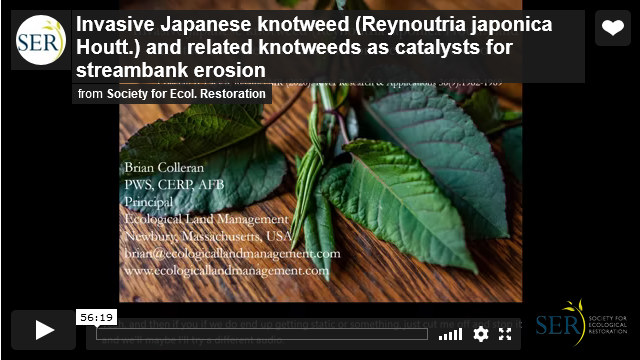Get into the (Knot)weeds
The internet has lots of information about knotweed. I would like to share some of the resources I've generated myself. I hope you find them helpful, and I’m happy to share other resources you might need.
I also teach for the Native Plant Trust, and in addition to being the current Shrubs instructor, I sometimes teach a class on invasive knotweeds.
RISCC June 2024 Webinar
The Northeast’s Regional Invasive Species and Climate Change Network was kind enough to host myself and Elisabeth Groeneveld as we talked about the challenges of knotweed and why this particular group of invasive plants requires a different frame of mind to create solutions that might not otherwise seem viable. Changing the problem changes the solutions
-

2014 Publication
Tropical Storm Irene in Vermont spread knotweed along a great number of waterways. I was able to supervise the removal of several thousand of these plants, on several different rivers. Over the course of this management, I collected samples for later analysis. What I found was that 70% of new plants originated from rhizominous propagules, rhizomes being an underground part of the plant.
-

2015 Publication
This paper summarizes observations from the 2nd field season after Tropical Storm Irene. Knotweed propagules washed downstream by Irene, which did not emerge for the entire growing season following that storm, emerged for the first time in the second growing season. The window for conducting Early Detection & Rapid Response management therefore needed to be extended.
-

2020 Publication
This paper gathers together all of the existing pilot studies, circumstantial evidence, and unintended findings from various sources to lay out the argument for how knotweed amplifies and exacerbates flooding
-

MACC Spring 2020 Article
This article explains how Japanese knotweed interacts with the Wetlands Protection Act in Massachusetts, how existing regulations can be used to encourage its control, and how this control would benefit the goals of the Act. This piece ran in the Spring 2020 Issue of the Massachusetts Association of Conservation Commission’s Spring Quarterly Magazine.
-

Summer 2020 AEP70 Article
This article was written for the summer newsletter of the Standing Committee on Environmental Analysis and Ecology of the National Transportation and Research Board. The articles previewed my 2020 publication, and laid out the case for knotweed control as an effective and meaningful means by which infrastructure can be protected from flooding, and climate resiliency promoted.
-

2021 Publication
On an extended trip to Chilean Patagonia, I discovered Japanese knotweed in Puerto natales. This was roughly 700 miles (1150 km) south of its nearest known population, near Puerto Montt. Subsequently, Chilean partners have found additional plants in Punta Arenas, 125 miles (200 km) further south, on the Strait of Magellan. These are the most southern documented populations in the world.
SER Webinar Spring 2021
In the Spring of 2021, I gave a webinar for the Society for Ecological Restoration (SER). As opposed to the lightning talk embedded below which I gave for the RISCC symposium, this talk got into the weeds. Literally. It walked through all of the sources that contributed to my 2020 publication (linked above), some field sites, and brought the disconnected threads together into strong rope.
RISCC Symposium January 2021
RISCC stands for the Northeast’s Regional Invasive Species and Climate Change Network. I gave a land manager’s lightning talk on how knotweed, erosion, and climate change interact at 2021’s annual management symposium.
